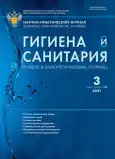Abstract
Introduction. The article presents results of the study of the impact of the personal protective equipment EP-4 (0) in various assembly (overalls, jacket and trousers, jacket and semi-overall) from power frequency electric field and electrical shock on the thermal state of workers in a heating environment at air temperature 34.8 °C and relative humidity 48%.
Materials and methods. The study involved three men aged 35.3±4.6 years. They did the physical exercise for 40 minutes, had comfortable relaxation for 30 minutes after work. Recorded indices included skin temperature and moisture sensation score on 11 parts of the body, body temperature in the ear canal, heart rate, clothes temperature, heat sensation score, moisture loss, moisture evaporation efficiency.
Results. Overalls using had the highest values of heat content, moisture score, heart rate changes, and body temperature increment. Heat content index in the body reached maximum permissible value using overalls earlier than other configurations.
Conclusion. The research data showed overalls have the most significant impact on the human thermal state, jacket and trousers have the least impact, jacket and semi-overall take an intermediate place. The configuration including jacket and trousers, jacket and semi-overall under specific operating conditions is the most optimal. Such PPE assembly can be recommended for use in the open area in the summer season at an air temperature of 35 °C and above, subject to protective requirements.






